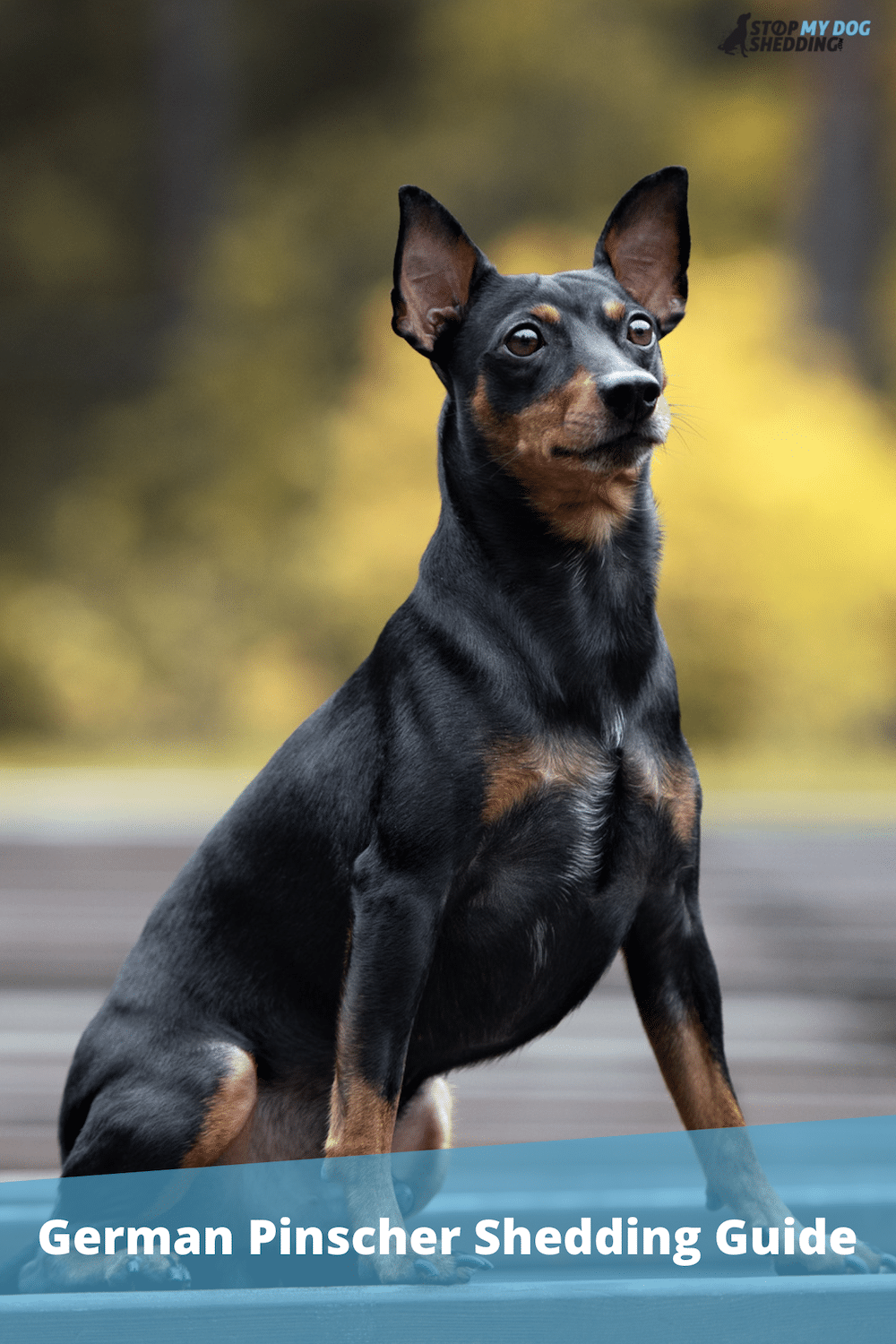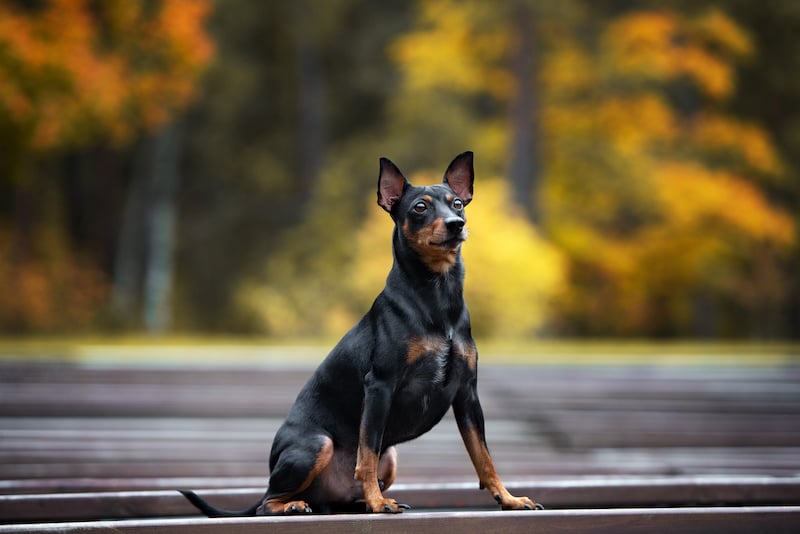The German Pinscher, which was once called the Deutscher Pinscher, is a mid-sized German dog with a coat in colors such as fawn, red, tan, blue, rust, or black. If the German Pinscher has caught your eye, you might be interested in taking this dog home.
Are German Pinschers heavy shedders?
German Pinschers shed moderately, but they’re single-coated, so their shedding isn’t excessive. The density of their coat can contribute to their shedding. Their short, smooth fur is easy to groom, though.
If you want to learn even more about German Pin shedding or what it takes to groom this unique breed, you’ve come to the right place.
I’ll also offer my top recommendations for reducing German Pinscher shedding and discuss whether this breed is considered hypoallergenic.
German Pinscher Shedding
If you want to skip the seasonal shedding stress, a German Pinscher could be the companion pup you’ve been looking for. However, this dog does still shed moderately.
Let’s examine the coat of the German Pin a little closer to see why.
German Pinschers have incredibly close-cropped fur that allows the dog to display its impressive musculature. In addition, that coat is smooth to the touch, which is one reason the German Pin sheds consistently.
As you may recall, if you’ve read this blog, wiry-coated breeds such as the Toy Poodle shed less. Although some dogs with smooth coats shed minimally, for the most part, the smoother the coat, the more shedding you should expect.
Another thing that increases the shedding rate is the German Pinscher’s coat density. This density makes up for how German Pins are single-coated, as their thicker coat provides warmth, but denser hair can also lead to more shedding.
Lastly, the length of the German Pin’s coat contributes to its shedding. Dog hair grows in four stages, and one of those stages entails the hair remaining at rest. And when a dog goes through all four hair growth stages quickly, their hair comes out faster than a dog with a less pronounced hair growth cycle.
The German Pinscher does have a few benefits when it comes to shedding. One is that it doesn’t shed seasonally. So each winter and summer, you won’t have to vacuum fervently around your house for several weeks to control floating fur. That’s nice to know.
Second, the German Pin’s short fur means that the amount of shed fur shouldn’t be overwhelming even when the dog is shedding.
Recommended: Go here to see our top-rated dog hair blow dryers
Grooming Your German Pinscher
German Pinschers make up for the grief they give you when shedding with their easy-as-pie grooming routine.
About once a week, use a rubber bristle brush or slicker brush on your German Pin. These brushes will not hurt your dog as you brush through the German Pin’s short, dense fur.
Make sure you brush through to their skin. This will take the German Pinscher’s skin oils and spread them across their body. Your dog’s coat might shine more, but far more important is that the distribution of oils can prevent dry skin.
Brushing your dog is a great way to control their shedding too. The rubber bristle brush or slicker brush will pull dead fur away from your German Pinscher’s body before it comes out on its own.
That said, if you feel like weekly brushing isn’t cutting it, then increase your dog’s brushing frequency to two, maybe even three times per week.
If your German Pin is mostly an indoor dog, then bathe him every six weeks and no more infrequently than eight weeks. For dogs that play rambunctiously outside, you might want to halve that.
That’s about all that grooming your German Pinscher requires, and their short fur shouldn’t need much in the way of trimming.
Reducing Excessive Shedding
While German Pinschers shed moderately throughout the year, if yours is shedding heaps, that could indicate a problem.
You can try a variety of solutions to get your German Pin’s coat healthier, so they’re happier.
I want to stress again the importance of regularly grooming your dog. Brushing and bathing your German Pin can control the dog’s shedding. That said, do make sure you’re not bathing your pup too often.
Monthly bathing is too much for the German Pinscher (and most dogs) and can dry out their skin. Dry skin is usually itchy, which means your pup will scratch at themselves until their fur comes out.
Bathing your German Pinscher with human shampoo rather than products formulated for dogs can also dry out their skin. If even dog shampoo is irritating your pup, try a gentler formula.
If it’s not dry skin that’s making your German Pin shed more than they should, it could be they have allergies to food in their diet. And one way to be sure of that is to remove ingredients from their diet one at a time, which can usually be done with the assistance of a vet.
You should also ensure your German Pinscher’s diet is full of nutrients, vitamins, and fats such as omega-3 and omega-6 fatty acids. If they’re eating mainly processed foods, your German Pin could have nutrient deficiencies.
While your dog is at the vet, get them checked for fleas, as these small blood-sucking insects can worsen shedding!
Are German Pinschers Hypoallergenic?
Knowing everything you do at this point about the German Pinscher, it should come as no surprise when I say no, this breed is not hypoallergenic.
However, the truth is, no dog is ever 100% hypoallergenic.
How can that be? Well, a perfectly hypoallergenic dog theoretically wouldn’t cause any allergies at all, and no dog can live up to that standard. After all, canine allergies are caused by their dander, not their fur. Dander is dead skin, and every dog has skin.
That said, some dogs are more hypoallergenic than others. Meaning, some breeds are less likely to trigger pet allergies than others.
What about German Pinschers?
Well, for one thing, they’re not on the American Kennel Club’s list of the most hypoallergenic dogs. So that’s a good indication they’re not ideal for allergy sufferers.
And second, as mentioned, they shed moderately. Even though it’s a dog’s dander (dead skin) that causes most allergies, dander attaches itself to a dog’s fur, so the more they shed, the more dander they’re likely to spread around the home.
Also worth mentioning is that the most hypoallergenic breeds tend to be small since smaller dogs have less skin than larger dogs.
So, when you put all that together, the German Pinscher probably isn’t ideal if you’re concerned about pet allergies since the most hypoallergic dogs are typically small and very low-shedding. Like the Affenpinscher, Toy Poodle, or Italian Greyhound, for example.
Is a German Pinscher Right for You?
Could the German Pinscher be the dog you’ve always wanted? Allow me to talk more about this breed and its personality so you can decide.
The German Pinscher was first displayed in a dog book as far back as 1884. At that point, it was called the Smooth Haired Pinscher. Another nickname of this mid-sized dog is the Deutscher Pinscher.
The original German Pins might have lived in the 1780s or even in the 15th century. They were used for guarding and hunting. In all the years since, the Seiden Pinscher or German Silky Pinscher and the Schweizer Pinscher–two German Pin varieties–went extinct.
German Pinschers are described as lively, intelligent, playful, friendly, and alert. Check out the following video to see the fun personality of the German Pinscher in action!
As a medium-sized dog, the average German Pin is between 17 and 20 inches tall and weighs up to 45 pounds. So he’s a little too big to be a suitable apartment dog. If you’re a homeowner, though, you should have the room to accommodate this breed.
You need suitable outdoor space for exercising the German Pinscher. This dog has boundless energy and is very athletic, and its prey drive is relatively strong. So always leash your pup when you go out!
German Pinschers are fine with other dogs, especially if they grew up with those dogs. Although the German Pin isn’t always the largest dog in the house, he can be a bit bossy, so watch out for that.
Smaller pets such as cats, rabbits, and hamsters will not get along well with a German Pin. The breed’s prey drive is too sharpened for that.
German Pinschers can befriend children, ideally older kids who are nine and up.
This breed can get rather possessive, sometimes over items that aren’t theirs, which can lead to a lot of barking. Fortunately, this misbehavior is correctable through training.
Bottom Line
The German Pinscher is a mid-sized German dog with a short, dense, smooth coat. A moderate shedder despite its single-layered fur, the texture and length of its coat does make the German Pin easy to groom.
This dog has a big personality, but if acclimated and socialized from a young age, he can befriend people and canines alike. So the German Pinscher could be the dog you’ve been searching for!













The picture is not a German Pinscher.